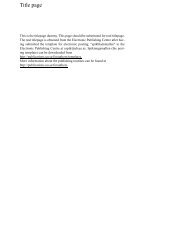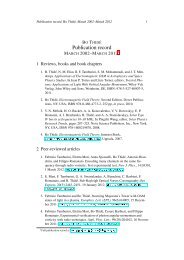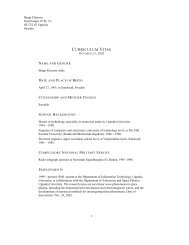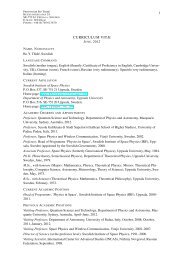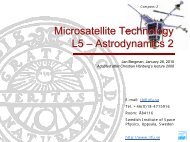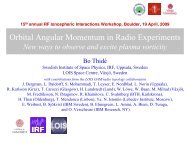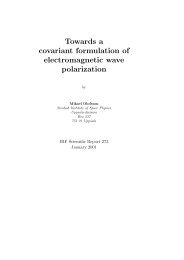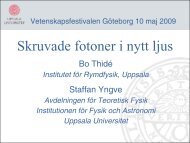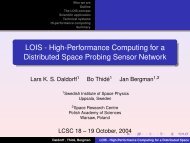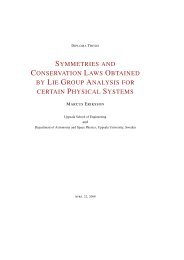Atmosphere-Ionosphere Mission - Swedish Institute of Space ...
Atmosphere-Ionosphere Mission - Swedish Institute of Space ...
Atmosphere-Ionosphere Mission - Swedish Institute of Space ...
You also want an ePaper? Increase the reach of your titles
YUMPU automatically turns print PDFs into web optimized ePapers that Google loves.
AIM SCIENCE 4<br />
vibrant multi-disciplinary research and a rapidly expanding frontier concerning the<br />
interaction <strong>of</strong> the upper atmosphere and ionosphere. This research concerns fields<br />
such as atmospheric electricity and electrodynamics (including that <strong>of</strong> thunderstorm<br />
centres), space weather, influence <strong>of</strong> solar activity on climate, to mention a<br />
few. In view <strong>of</strong> this important activity and, on the other hand, the decades long<br />
trend <strong>of</strong> missions further and further out in space, we would like to see a mission<br />
back to the Earth with a fresh, innovative perspective which also comprises<br />
environmental and technology aspects.<br />
The atmospheric-ionospheric regions below typical space shuttle altitudes (350–<br />
400 km) are very poorly explored by measurements in situ because <strong>of</strong> atmospheric<br />
drag which shortens satellite lifetimes. This region is <strong>of</strong> major scientific importance<br />
because it is a transition region between the neutral atmosphere and the completely<br />
ionised magnetosphere, with strong ionisation gradients, electric jets, complicated<br />
chemistry, turbulence, dusty plasma and complex physical phenomena. The processes<br />
in this transition region connect the solar and magnetospheric effects with<br />
the atmospheric response which, in fact, determine space weather in the Earth’s<br />
environment. This region is also the part <strong>of</strong> the Earth’s atmosphere where electromagnetic<br />
radiation from natural sources such as lightnings, and artificial sources<br />
such as radio, TV and radar transmitters, exhibit resonance and other interaction<br />
phenomena. The impact <strong>of</strong> these natural and man-made effects on the Earth’s space<br />
environment are <strong>of</strong> major public concern. Hence, studies <strong>of</strong> such effects are called<br />
for. On the other hand, the ionosphere is a region <strong>of</strong> closure <strong>of</strong> magnetospheric current<br />
systems and a reflection layer for Alfvén wave resonators. Consequently, the<br />
proposed mission is <strong>of</strong> considerable interest also for the solar wind-magnetosphereionosphere<br />
coupling.<br />
The AIM satellites are to be designed for correlated studies <strong>of</strong> phenomena associated<br />
with electromagnetic radiation, <strong>of</strong> natural as well as anthropogenic origin,<br />
in the ELF to HF (DC–30 MHz) and microwave ranges as well as UV, X-ray, and<br />
gamma radiation. We suggest a first constellation <strong>of</strong> two satellites in the same low<br />
altitude elliptical orbit in order to help resolve the spatio-temporal ambiguity <strong>of</strong><br />
space measurements as illustrated in Figure 1.<br />
The high-frequency receiver on Freja satellites operated only up to 4 MHz with<br />
short snapshots <strong>of</strong> 0.5 ms. Still, it provided a wealth <strong>of</strong> new information on parametric<br />
interactions between Langmuir and lower hybrid waves. An example <strong>of</strong> a<br />
time-series recorded by this instrument is shown in Figure 2 . The AIM instrumentation<br />
will provide a considerably more comprehensive data base with time-series<br />
data which will be used for advanced study <strong>of</strong> wave processes in the topside ionosphere.<br />
2.1 Man-made radio wave effects on the atmosphere-ionosphere<br />
In situ measurements <strong>of</strong> the turbulence driven by a powerful radio wave in the ionosphere<br />
has been recognised as the single-most important experiment to advance our<br />
understanding <strong>of</strong> the response <strong>of</strong> the ionospheric plasma during electromagnetic ir-<br />
<strong>Atmosphere</strong>-<strong>Ionosphere</strong> <strong>Mission</strong><br />
Elaborate Science Case



